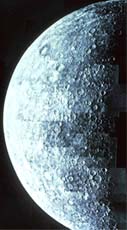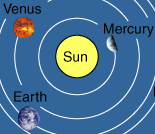Mercury

|
 Mercury's small orbit keeps it so close to the Sun that, when viewed from Earth, Mercury is almost always seen in twilight. Mercury receives the maximum amount of sunlight, but its albedo is only 0.1 compared with 0.39 for the Earth, so it is not as bright as it would be with a higher albedo.
|
The cliffs and craters (up to 800 miles across) of Mercury were first imaged by NASA's Mariner 10 which passed it at an estimated distance of 705 km on Mar 29, 1974. Mercury's wrinkled surface may be the result of the planet shrinking as it cooled after formation 4.5 billion years ago. Mariner 10 passed by again on Sep 21, 1974 at 48,069 km and a third time on Mar 16, 1975 at a distance of 307 km.
Next to the exceptional orbit of Pluto, Mercury has the orbit with the greatest eccentricity (e = .208) and the greatest inclination to the ecliptic plane ( 7°).
Solar System Illustration
Solar System Concepts
Mercury Concepts
| HyperPhysics********** Astrophysics | R Nave |